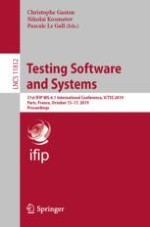This book constitutes the refereed proceedings of the 31st IFIP WG 6.1 International Conference on Testing Software and Systems, ICTSS 2019, held in Paris, France, in October 2019. The 14 regular papers and 3 short papers presented were carefully reviewed and selected from 30 submissions. This year also included an additional industrial paper. ICTSS is a series of international conferences addressing the conceptual, theoretic, and practical problems of testing software systems, including communication protocols, services, distributed platforms, middleware, embedded and cyber-physical systems, and security infrastructures.
